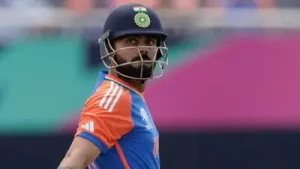
Just five runs in three innings, including a golden duck, at the ongoing T20 World Cup; has Virat Kohli suddenly lost his form? The answer to this question is an emphatic no.
Revisit Kohli’s cover drive against Naseem Shah in the game against Pakistan. There was a hint of out-swing, but Naseem had missed his length a fraction and it was a half-volley. Kohli used the swing to free his arms and a gorgeous drive followed, which went past the cover fielder to the fence. It was the first ball that Kohli faced in the match and he looked to be in supreme touch.
Kohli departed a couple of deliveries later, as the New York pitch played its trick. The ball was a little short and wide. And at the last moment, it moved a touch. Kohli could only toe-end it to Usman Khan at cover point. He was done in by that little movement off the deck.
A batsman’s form can’t be judged on the lottery pitches at the Nassau County International Cricket Stadium. There was always a wicket-ball round the corner. A batsman needs a bit of luck to score runs on such pitches. Kohli didn’t have any in the three matches he played at the venue.
“When you get three low scores, it doesn’t mean he is not batting well,” the legendary Sunil Gavaskar rightly refused to read too much into Kohli’s three single-digit scores, as he spoke on Star Sports after India’s game against the United States. “Sometimes you get good deliveries. Any other day, the ball would have gone wide or over the slip for a boundary. Today it didn’t. So, there’s nothing to worry about. We have to show faith in him. Many believe that he is going to come good, sooner rather than later,” Gavaskar added.
Kohli came to the T20 World Cup in red-hot form, after scoring more than 700 runs, and winning the Orange Cap in the IPL. His performance for Royal Challengers Bengaluru prompted the Indian team management to promote him as an opener at the T20 World Cup, at the expense of Yashasvi Jaiswal. But the conditions in New York made the RCB playbook redundant. India have sort of sacrificed their best batter by sending him to open the innings.
Is there a difference between opening and batting at No. 3, for a one-drop batsman can be required to play the second ball of the innings? Rahul Dravid repeatedly faced this question when he was in his pomp as a cricketer. The former India captain, who is now the head coach of the Indian team, always spoke about the mindset. The mindset of a No. 3 batsman is different from an opener and it makes a big difference.
No. 3 is Kohli’s natural habitat. He has scored almost all his runs and helped India win countless matches playing in that position. Yes, he has been very successful as an opener for RCB, but international cricket is a different ball game and sending him at the top, especially in tricky conditions, is a high-risk approach. It hasn’t paid off yet.
India have secured their Super Eights qualification and as they move for the Caribbean leg of the tournament, will the team management have a rethink about Kohli’s batting position? Historically, Indian teams have been pretty stubborn as regards to their thought process. At the 2007 World Cup (50-over format), then head coach Greg Chappell stuck to playing Sachin Tendulkar at No. 4, notwithstanding that the move was hurting the team. It eventually resulted in group-stage elimination for India.
It needs to be seen if the current team management is ready to be flexible with the batting order at the business end of the tournament. Yes, Rishabh Pant has gotten into the groove at No. 3. But the wicketkeeper-batter can be equally effective at No. 4. Meanwhile, sending Kohli at No. 3 might help him get back to his comfort zone and play at his own pace.
Jaiswal is a specialist opener and will provide a left-right combination at the top if he partners Rohit Sharma. Then, Kohli at No. 3 followed by Pant and Suryakumar Yadav at No. 4 and 5 will make India’s batting meatier against stronger teams. It will also keep the left-right combination going right through the middle-order.




